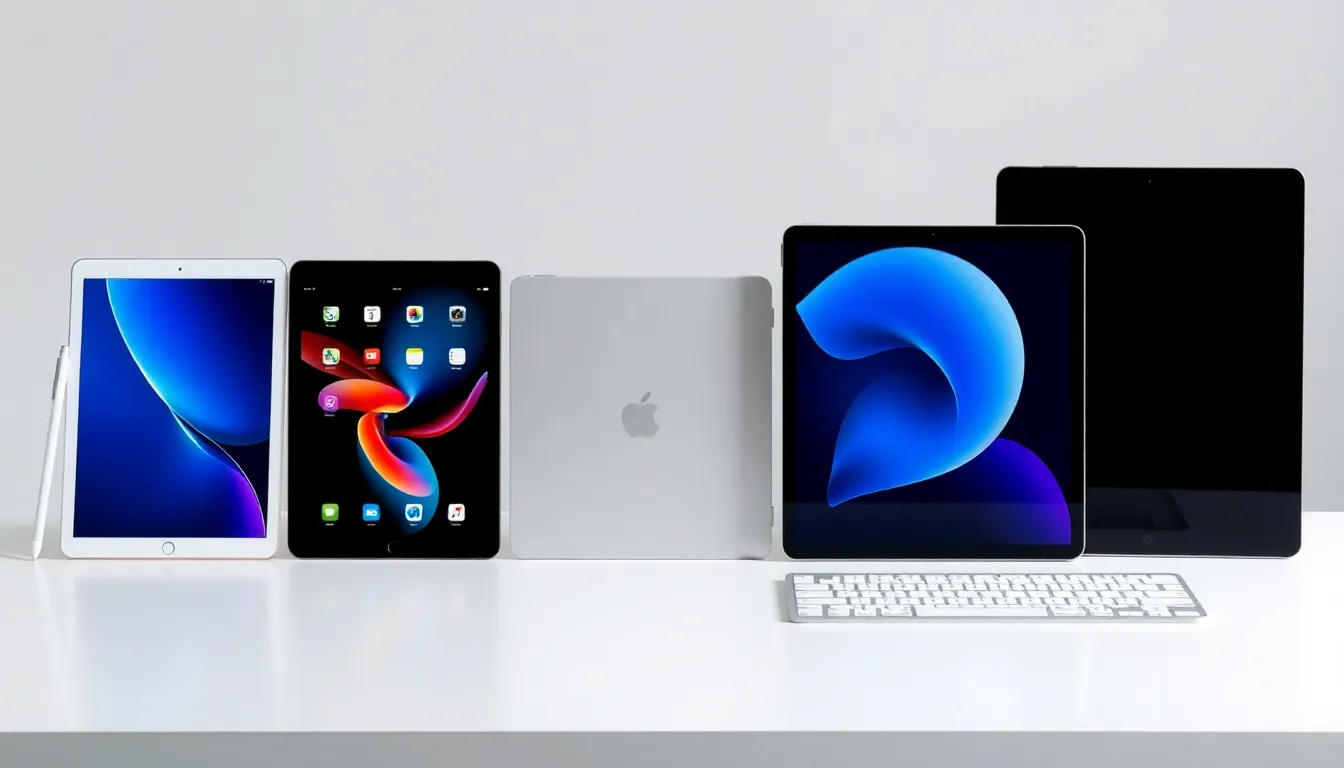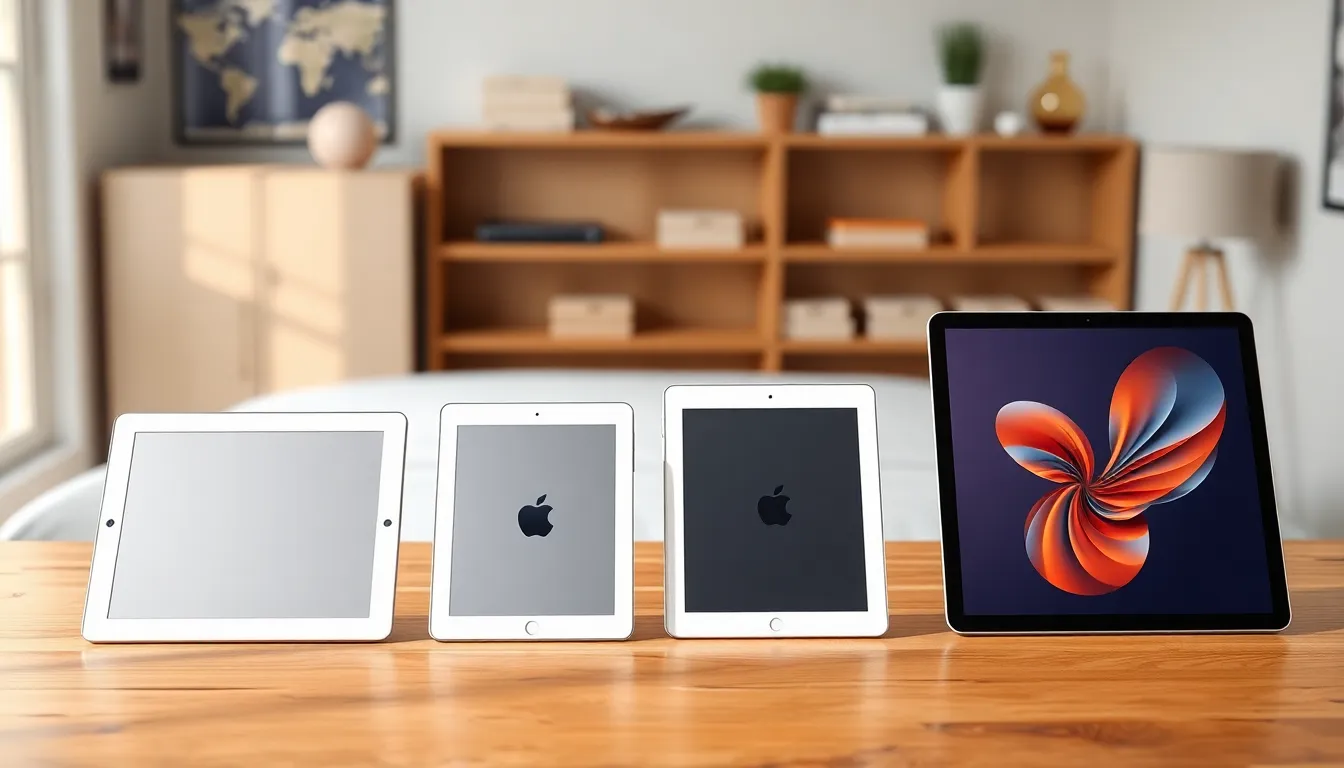In a world where technology evolves faster than a cat meme goes viral, the iPad has carved out its own niche. With sleek designs and powerful capabilities, it’s no wonder that Apple fans often find themselves asking, “How many iPads are there?” Spoiler alert: it’s more than just a few.
Table of Contents
ToggleOverview of iPad Models
Apple has released various iPad models since the product’s inception in 2010. The lineup includes the standard iPad, iPad Air, iPad mini, and iPad Pro. Each model caters to different user needs and preferences.
The standard iPad serves as a versatile choice for everyday tasks, featuring a 10.2-inch display and strong performance. This model appeals to both students and casual users looking for affordability combined with quality.
In contrast, the iPad Air focuses on lightweight design and powerful capabilities. With its larger display and advanced processing power, it targets creative professionals and enthusiasts. The latest generation provides users with impressive graphics performance, ideal for tasks like graphic design.
For users seeking portability, the iPad mini combines compact size with robust features. This model boasts an 8.3-inch display and supports the Apple Pencil, offering convenience for note-taking and drawing on the go. It’s perfect for travel and for those who prioritize mobility.
The iPad Pro stands out as Apple’s flagship model, designed for high-end performance. Options include 11-inch and 12.9-inch displays, enabling a dynamic viewing experience for professionals. Enhanced specifications support demanding applications like video editing and 3D design.
More than the hardware specifications, the iPad ecosystem includes a vast range of apps optimized for each model, enhancing functionality and user experience. As technology advances, Apple continues to innovate within its iPad range, providing choices for varying needs and preferences.
Current iPad Lineup

Apple offers a diverse lineup of iPads, each tailored to specific needs and preferences. Understanding the differences helps users select the most suitable model.
Standard iPad
The standard iPad serves as an entry-level device, perfect for casual users and students. It features a 10.2-inch Retina display and supports the first-generation Apple Pencil. Users appreciate its versatility for tasks like browsing, streaming, and light productivity. With a powerful A13 Bionic chip, this model balances performance and affordability. Pricing starts around $329, making it accessible for many people.
iPad Mini
The iPad Mini boasts a compact 7.9-inch display, ideal for those seeking portability. It stands out for its lightweight design, fitting easily in bags or hands. Users love the A15 Bionic chip, providing capabilities for demanding apps and games. The device also supports the second-generation Apple Pencil, enhancing creative possibilities. Prices typically begin around $499, appealing to users who want power in a small form factor.
iPad Air
The iPad Air combines high performance and sleek design, catering to creative professionals. Its 10.9-inch Liquid Retina display delivers vibrant visuals, enriching the user experience. Equipped with the M1 chip, the iPad Air excels in multitasking and handling demanding applications. Users find the device ideal for graphic design, video editing, and more. Pricing starts at $599, making it a viable option for serious creatives.
iPad Pro
The iPad Pro represents Apple’s flagship tablet, showcasing cutting-edge technology. Users can choose from 11-inch and 12.9-inch models, each with stunning Liquid Retina displays. The M1 chip powers this device, ensuring top-tier performance for intensive tasks. With support for advanced accessories like the Magic Keyboard and second-generation Apple Pencil, it caters to professionals in various fields. Starting prices begin at $799, transforming the iPad Pro into a powerful laptop alternative.
Historical iPad Evolution
The iPad’s evolution showcases Apple’s innovation in the tablet market. Various models have emerged since its inception, each designed to meet distinct user needs.
First Generation iPads
Introduced in April 2010, the first iPad set a foundational precedent for the tablet category. It featured a 9.7-inch display and was powered by the A4 chip, providing a smooth user experience. The model ran on iOS, catering to users looking for an intuitive interface. A range of storage options allowed customers to choose between 16GB, 32GB, and 64GB variants. The first generation expanded access to Apple’s ecosystem, making it appealing to casual users and tech enthusiasts alike.
Major Updates Over the Years
Subsequent iPad generations consistently introduced significant enhancements. The second generation, launched in March 2011, slimmed the design and added cameras. Each iteration has ushered in improved processing power, starting from the A5 chip to the M1 chip in the recent iPad Pro. The display technology evolved, shifting from standard to Liquid Retina in newer models. Furthermore, new features like support for the Apple Pencil and Smart Keyboard increased productivity. These updates confirmed Apple’s commitment to refining user experience and meeting diverse demands.
Market Trends and Statistics
Apple’s iPad market demonstrates significant growth, underscoring its popularity among consumers. In the third quarter of 2023, Apple reported 43 million iPads sold. This figure reflects a 20% increase compared to the previous year, emphasizing the iPad’s strong market presence amid competition.
Retail pricing shows variability across models. The standard iPad starts at around $329, while the iPad mini begins near $499. The iPad Air generally has a price tag starting at $599, with the iPad Pro at a higher entry point of $799. These diverse prices cater to various user demographics and needs.
Market research highlights iPad’s dominance in the tablet segment. In 2022, iPad accounted for approximately 30% of the global tablet market share. Samsung and Amazon follow, holding 20% and 10% respectively. This data solidifies the iPad’s position as a leading multimedia and productivity tool.
Usage statistics reveal diverse applications of the iPad. Students comprise a significant portion, utilizing the device for educational purposes, while professionals leverage its power for creative tasks. Productivity apps have seen a 35% increase in downloads among iPad users, showcasing the device’s evolving capabilities.
Sales figures also present an intriguing trend. During the 2023 holiday season, iPad sales surged by 50%, attributed to gift-giving patterns and holiday promotions. Apple’s marketing strategies play a crucial role in maintaining and boosting demand.
The iPad’s market performance illustrates its strength across various sectors. With ongoing innovations and updates, it remains a vital contender in the tech landscape, appealing to a broad range of users and adapting to their evolving needs.
The iPad has proven to be a versatile and powerful device since its inception. With a range of models designed to meet diverse user needs it continues to adapt and thrive in the competitive tablet market. Its impressive sales figures and market share reflect its popularity among students professionals and casual users alike. As Apple maintains its commitment to innovation the future of the iPad looks promising with potential for even more advancements and features.




